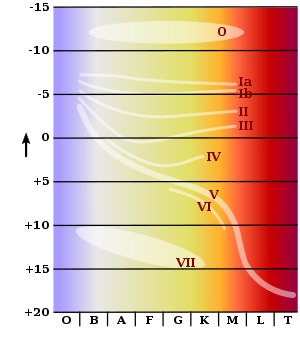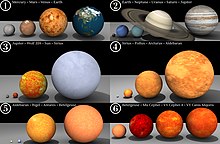Red supergiant
A red supergiant ( English red supergiant , RSG ) is a very extensive Stern , who has reached the end of its development. It has a surface temperature of less than 4300 K and shows the spectral properties of supergiants with a very small spectral shift due to gravitation due to their large radii.
Characteristics
It resembles a red giant in appearance , but is much larger and more massive. A supergiant can reach 10 to 40 times the mass and over 1500 times the radius of our sun . The luminosity can increase up to 100,000 times the luminosity of the sun. The surface temperature is between 3450 K and 4300 K and thus corresponds to the spectral classes late K to M. The red supergiants enrich the interstellar matter with heavy elements with their stellar wind , with mass loss rates of 10 −6 to 10 −3 solar masses per year . In the outgoing stellar wind, stellar grains of OH, H 2 O and SiO often form . Due to their short lifespan of a few million years, the red supergiants belong to the young population I. In addition, dust covers form from the outflowing stellar wind, which is why these stars show a strong infrared excess . The dust formation leads to a strong extinction in the optical and near infrared around red supergiants. The determination of the bolometric luminosity is therefore often fraught with a large error in this class of stars.
variability
All red supergiants belong to the variable stars and are assigned to the slowly irregularly changing stars or the semi- regularly changing stars . The cause is radial oscillations of the atmosphere of the RSG in the basic oscillation , the first or even the second harmonic with periods of the order of a few hundred days. In addition, variations in the light curves with cycle lengths of up to 4000 days, which are referred to as long secondary periods, have been detected. Its cause is not yet understood. In addition to the regular components of brightness changes, red supergiants can experience irregular variability caused by huge convection cells on the surface of the RSG. The convection cells can take up up to 20 percent of the surface. In the near infrared, the red supergiants show a well-defined period-luminosity relationship . The high luminosity of the RSG therefore enables the distance to be determined in a much larger area than with all other pulsating variables such as the Cepheids . In addition to the brightness, the spectra of red giants are also variable. For example, HV 11423 moves back and forth in the Small Magellanic Cloud within months between an early K and a middle M spectrum.
development
After the hydrogen burn has ended, the jet pressure drops . The gravitational forces predominate , which become noticeable in a contraction of the core and heat it to over 100 million Kelvin . At this temperature the star reaches the helium burn in its core. The next burning process, carbon burning, starts at 500 million Kelvin. Other stars above 13 solar masses achieve neon glow and furthermore further stages of nucleosynthesis . The still existing hydrogen burning zone slowly continues towards the surface of the star .
By disturbing the internal equilibrium, the gas pressure inside the star increases. This leads to an expansion of the outer gas layers, which cool down and emit light predominantly in the reddish spectral range. The expansion reaches its maximum when the star has found its inner balance. This can reach up to a thousand times the radius of our sun. For comparison: In our solar system this would roughly correspond to the orbit of Jupiter , i.e. about 5.2 times the orbit of the earth .
By the time the star in the Hertzsprung-Russell diagram (HRD for short) reaches the supergiant range, it loses around 25% to 33% (empirically uncertain parameter) of its mass. This is the point where most of the giants drop down in the HRD and fail to make it to the supergiant.
A very massive star even wanders horizontally through the HRD several times, becoming a red supergiant and eventually migrating back again. The exact course of evolution and the mass limits are heavily dependent on the chemical composition of the star and the loss of mass due to stellar winds. During these mass ejections, the star may lose a considerable amount of mass through episodes with strong stellar winds.
Some of the red supergiants develop into supernovae of type IIP (plateau). These core collapse supernovae arise when there is no longer any fuel available in the core of the star for thermonuclear reactions , in which energy is released, and the degenerative pressure can no longer prevent a gravitational collapse. This scenario is supported by numerous supernovae of type IIP in nearby galaxies, where the previously detected red supergiant could no longer be observed after the core collapse supernova. The interaction of the supernovaejecta with the stellar wind of the red supergiant supports this interpretation. The result of such a supernova is a neutron star or black hole . The other red supergiants migrate back into the blue part of the HRD due to severe mass losses and explode as a supernova of type Ib or Ic while they are in the phase of a Wolf-Rayet star .
The development paths for non-rotating, non-magnetic stars with solar metallicity are shown in the following table, whereby the development paths can change considerably through mass exchange in binary star systems:
| M☉ | Development path |
|---|---|
| 30-40 | O-star → Blue super giant → Red super giant → WNe → WCe → SN Ibc |
| 25-30 | O-Star → Blue Super Giant → Red Super Giant → Yellow Hyper Giant → SN II-l / b |
| 10-25 | O-Star → Red Super Giant → Cepheids → SN IIP |
Circumstellar shells

Red supergiants can lose up to 50% of their former main sequence mass due to strong variable stellar winds. The rate of mass loss fluctuates between 10 −3 solar masses per year in some eruptions and can drop to values of 10 −7 M sun . Based on theoretical considerations, the high mass loss should be a consequence of high radiation pressure in combination with atmospheric activity. In the radio range, lines of carbon monoxide, water, ammonia, hydrogen sulfide, silicon oxide and hydroxyl have been detected around red supergiant. With the measured outflow velocity and the radial distribution around the stars, the stellar wind of the last thousand years can be reconstructed for the supergiants. The outflow velocities are in the order of magnitude of a few dozen kilometers per second and the typical temperature of the gas in the circumstellar envelope is between 300 and 700 K. With the high rates of mass loss, the red supergiants are one of the important sources that transport interstellar matter with heavy elements enrich.
Examples
Betelgeuse and Antares A are well-known red supergiants. One of the largest known stars to date, WOH G64, has about 2000 times the diameter of our sun.
| Surname | Dimensions | radius | Luminosity |
|---|---|---|---|
| Antares (α Sco A) | 15–18 m ☉ | 820 R ☉ | 90,000 L ☉ |
| Betelgeuse (α Ori) | 20 M ☉ | 1000-950 R ☉ | 135,000 L ☉ |
| Garnet star (μ cep) | 25 M ☉ | 1420 R ☉ | 350,000 L ☉ |
| 119 Tauri | 15–18 m ☉ | 600 R ☉ | 50,000 L ☉ |
| VV Cephei A | 25–40 M ☉ | 1900-1600 R ☉ | 275000-575000 L ☉ |
Web links
- Red supergiant spews matter
- Stars - development and end (also for non-specialists) (Uni Mainz) (PDF; 6.0 MB)
- Formation of a massive star (University of Erlangen) (PDF; 2.8 MB)
Individual evidence
- ^ Philip Massey, Emily M. Levesque, Bertrand Plez, and KAG Olsen: The Physical Properties of Red Supergiants: Comparing Theory and Observations . In: Astrophysics. Solar and Stellar Astrophysics . 2008, arxiv : 0801.1806v2 .
- ^ Emily M. Levesque, The Physical Properties of Red Supergiants . In: Astrophysics. Solar and Stellar Astrophysics . 2009, arxiv : 0911.4720 .
- ↑ L. Verheyen, M. Messineo, and KM Menten: SiO maser emission from red supergiants across the Galaxy: I. Targets in massive star clusters . In: Astrophysics. Solar and Stellar Astrophysics . 2012, arxiv : 1203.4727v1 .
- ↑ C. Hoffmeister, G. Richter, W. Wenzel: Veränderliche Sterne . 3. Edition. Springer Verlag, Berlin 1990, ISBN 3-335-00224-5 .
- ^ Ming Yang and BW Jiang: The Period-Luminosity Relation of Red Supergiant Stars in the Small Magellanic Cloud . In: Astrophysics. Solar and Stellar Astrophysics . 2012, arxiv : 1205.1275v1 .
- ↑ A. Unsöld, B. Baschek: The new cosmos. P. 299 (7.A)
- ↑ Joachim Hermann: dtv-Atlas zur Astronomie p. 189.
- ↑ Hans-Ulrich Keller: Astrowissen p. 173.
- ↑ A. Unsöld, B. Baschek: Der neue Kosmos , page 295–299 (7.A)
- ↑ M. Fraser et al .: Red and dead: The progenitor of SN 2012aw in M95 . In: Astrophysics. Solar and Stellar Astrophysics . 2012, arxiv : 1204.1523 .
- ^ Sylvia Ekström, Cyril Georgy, Georges Meynet, Jose Groh, Anahí Granada: Red supergiants and stellar evolution . In: Astrophysics. Solar and Stellar Astrophysics . 2013, arxiv : 1303.1629v1 .
- ↑ D. Teyssier et al .: Herschel / HIFI observations of red supergiants and yellow hypergiants: I. Molecular inventory . In: Astrophysics. Solar and Stellar Astrophysics . 2012, arxiv : 1208.3143 .
- ↑ Jumk.de. Retrieved October 2, 2013 .

